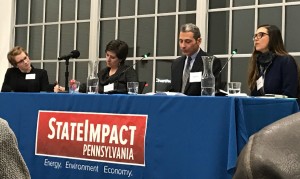From the Report by Scott Blanchard, StateImpact Penna., January 30, 2019
Three experts whose work focuses on issues related to climate change discussed whether it’s possible for the U.S. to eventually get its electricity from carbon-emission-free sources — and what that might look like.
Paulina Jaramillo, Ivonne Peña and Greg Reed spoke with moderators Reid Frazier and Amy Sisk, two StateImpact Pennsylvania reporters who moderated the panel at “The future of energy: Can we get to zero carbon?” at the Energy Innovation Center in Pittsburgh on Tuesday night. An estimated 140 people attended the event, produced by StateImpact and partners WESA and The Allegheny Front in coordination with the EIC.
Look for a full report on the discussion in a February episode of StateImpact’s ‘energy, explained’ podcast. Meanwhile, here are three thought-provoking responses from the panelists during the discussion:
>>> Greg Reed is a professor of electric power engineering at the University of Pittsburgh’s Swanson School of Engineering, and director of Pitt’s Center for Energy and the Energy GRID Institute. His research has focused on topics including advanced electric power grid and energy generation, energy storage and micro-grids.
He was asked why it’s important to address a global issue on a local scale and talked about Pittsburgh’s involvement in the District Energy Initiative, a “concept of a grid of microgrids in and around the city of Pittsburgh, where we can look at building in sustainability, resiliency, reliability, and security into our grid infrastructure, especially at the local distribution level.
“When you look to try to do this either statewide or nationally, as you can see from a national perspective, we don’t agree on much. It’s very hard to get things done. … What we really want to do is become a global leader here in Pittsburgh with how we transform into the 21st century into a clean and renewable energy environment and reduce emissions at the same time. … Cities can take more control than overall states or again national entities. I like to say that cities, especially like Pittsburgh, are small enough to get these things done but big enough to matter.”
>>> Paulina Jaramillo is an associate professor of engineering and public policy at Carnegie Mellon University and co-director of the Green Design Institute. Her research has focused on life cycle assessment of energy systems with an emphasis on climate change impacts and mitigation research. She was asked to weigh in on Gov. Wolf’s ambitious goal to reduce the state’s greenhouse gas emissions 26 percent by 2025, and 80 percent by 2050.
Jaramillo said there’s a difference between the energy sector and electricity, and that “decarbonizing Pennsylvania is not just about decarbonizing the electricity sector.” The latter, she said, is “actually the low-hanging fruit.” The challenge is the transportation sector, including trucking, trains and air travel.
“The technologies for decarbonizing those end uses have not received as much attention as electricity. Same thing with the industrial sector. … How do we decarbonize that? I’m optimistic about our potential for decarbonizing the electric sector. … My concern is for the other sectors … because we all think about electricity first.”
But when the discussion is to electrify everything, she said, the problem is how to electrify airports or long-distance shipping, for example. Hydrogen could be a way to “electrify those sectors that are hard to electrify,” she said.
“We probably are going to need hydrogen to get to some of these hard to decarbonize sectors,” she said.
>>> Ivonne Peña is an energy analyst who is passionate about the dilemmas countries face in their electricity sectors, including making them more climate-resilient, meeting demand and reducing carbon emissions. She has worked for the National Renewable Energy Laboratory in the U.S. and Colombia’s Energy and Gas Regulatory Commission.
If there’s one idea or technology that has her excited, she said, it’s batteries.
“Second-generation batteries,” she said. “Eighty percent of batteries in the power sector in the U.S are lithium ion batteries. And I’m excited about the prospects for lithium metal batteries. They promise to have more energy density, and prices seem to also be going down.”
She referred to the cost of lithium metal batteries moving toward a “magic number that Tesla has for comparing combustion engines with electric vehicles. Probably like $100 per kilowatt hour would make electric vehicles competitive compared to combustion engines.”


{ 1 comment… read it below or add one }
This is lots to consider in getting to Zero.
There are several things not being being mentioned in these discussions. Agriculture has a conversation about livestock farming. I’ve seen claims from 4 to 40% of the CO2 being produced worldwide by domestic animals. (I suspect vegetarians are responsible for some of this.)
Long distance movement of food is another contributor. Grain production is concentrated in the Upper Midwest and is heavily mechanized, for example. Winter food from Mexico and Central America even the East Indies make a contribution.
Another area is off-road machinery, such as pipeline, road, mining and farming equipment. They require a lot of energy. Coal fired electricity is a significant problem.
A third is the military, with tanks, movement of supplies, ships, airplanes. Look who many of our national enemies are: Iran, Russia, for starters, and look what we do in Libya and Venezuela, Nigeria and many others. Look what we put up with in Saudi Arabia. Military power depends on oil products. This generates CO2 and other pollutants.
S. Tom Bond, Lewis County, WV